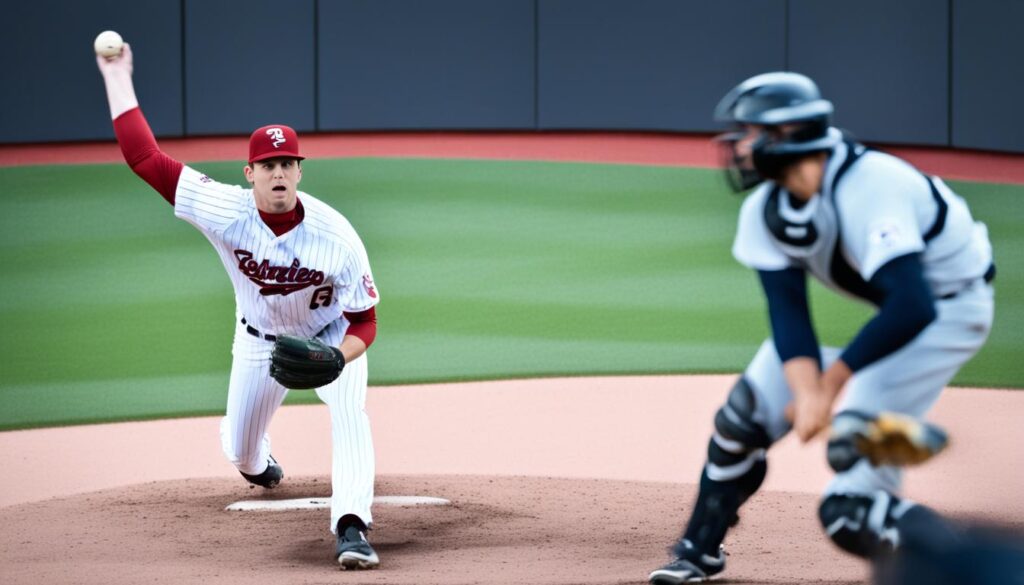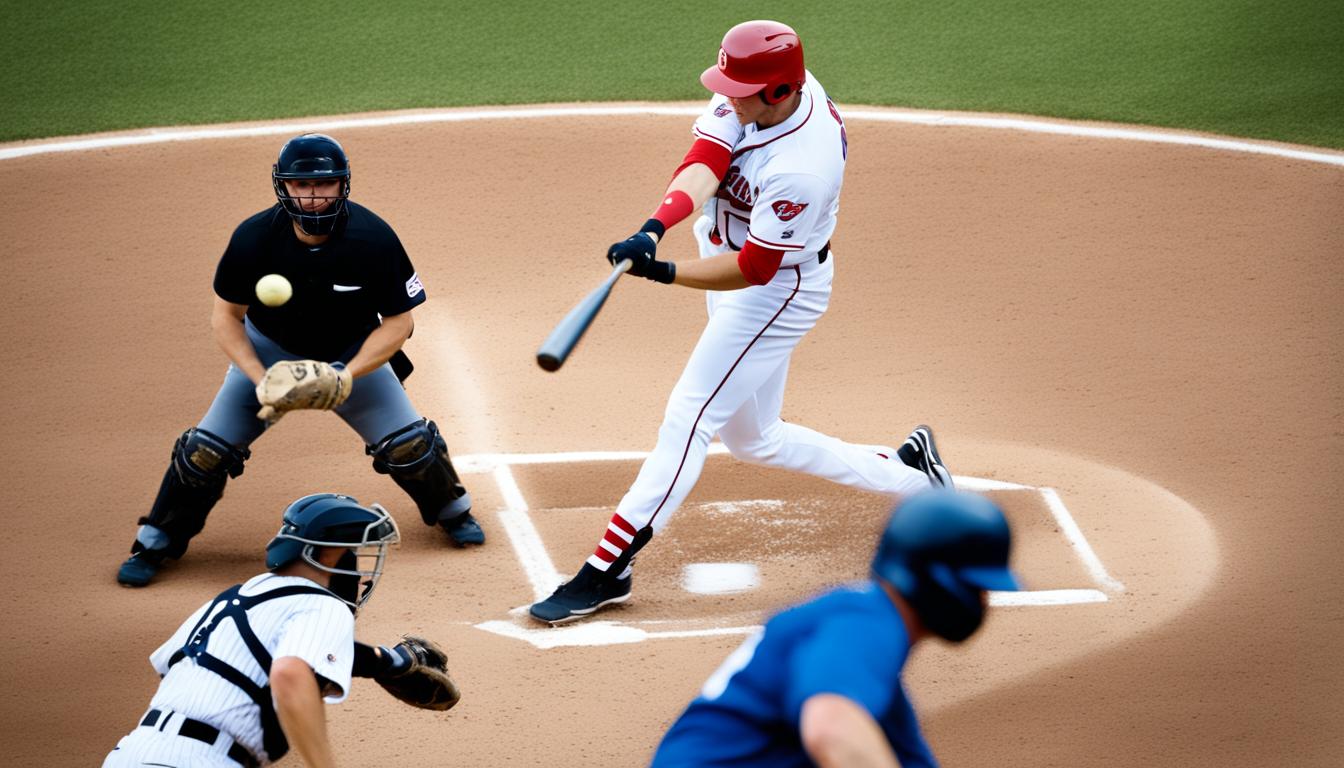
Image Credit-Pinterest
Baseball is a game of strategy, skill, and excitement. But have you ever wondered what happens when a batter swings and misses three pitches? Or why is it considered a win for the pitcher? Let’s delve into the world of strikeouts and unravel their significance in the game.
Key Takeaways:
- A strikeout occurs when a batter fails to make contact with the ball on three consecutive pitches.
- It is an out for the offensive team and a success for the pitcher and the defensive team.
- Strikeouts are pivotal in analyzing a pitcher’s performance and a team’s effectiveness.
- While strikeouts garner attention, singles play a crucial role in advancing runners and scoring runs.
- Understanding the dynamics of both strikeouts and singles provides a deeper comprehension of baseball strategies.
How Does a Strikeout Work in Baseball?
When a batter steps up to the plate in a game of baseball, their primary objective is to make contact with the pitched ball and put it into play. However, there are instances where the batter fails to achieve this goal, resulting in a strikeout.
A strikeout occurs when a batter accumulates three strikes. Now, let’s take a look at the different types of strikeouts that can happen during a game:
- Swinging and missing: This is the most common type of strikeout, where the batter swings at the pitch and fails to make contact with the ball.
- Looking at a called strike: In this scenario, the batter does not swing at a pitch that is ruled a strike by the umpire.
- Foul-tipping a third strike into the catcher’s glove: Sometimes, a batter manages to foul-tip a third strike directly into the catcher’s glove, leading to an out.
The different types of strikeouts contribute to the overall statistics and analysis of the game. They provide valuable insights into a batter’s performance and a pitcher’s ability to deceive and overpower the opposition.
The Importance of the Strikeout in Baseball
The strikeout is an essential element of baseball, carrying significance for both pitchers and the defensive team as a whole. For pitchers, recording strikeouts showcases their ability to overpower batters and prevent solid contact with the ball. It serves as a key factor in evaluating a pitcher’s effectiveness and overall performance.
Additionally, strikeouts hold importance in assessing team statistics and the efficiency of a team’s pitching staff. Analyzing strikeouts helps gauge a team’s ability to get outs efficiently, contributing to their overall defensive strategy and success.
The Impact on Pitchers
Recorded strikeouts demonstrate a pitcher’s skill in overpowering batters, making it more challenging for them to connect with the ball. Pitchers who consistently record strikeouts are often regarded as dominant forces on the mound, commanding respect from opposing teams.
The Defensive Team’s Perspective
Each strikeout represents an out for the defensive team, helping to minimize scoring opportunities for the opposing team. Teams with strong pitching staffs that excel in recording strikeouts have a better chance of keeping their opponents at bay and securing victories.
“A well-placed strikeout can instantly shift momentum, energizing the pitcher, the defense, and the crowd, while deflating the opposing team’s offense.” – Baseball Analyst
- Strategically timed strikeouts can disrupt offensive rallies and deflate the confidence of the opposing batters.
- Each strikeout reduces the likelihood of a batter reaching base, limiting potential scoring opportunities.
- The strikeout allows the defensive team to gain control and dictate the pace of the game.
In summary, strikeouts play a vital role in the game of baseball. They highlight a pitcher’s prowess on the mound and contribute to the overall success of the defensive team. By understanding the importance of strikeouts, players, coaches, and fans gain valuable insights into the dynamics of the game and its strategic elements.
Understanding the Strikeout Rate in Baseball
The strikeout rate in baseball is a key metric used to evaluate pitchers and their ability to generate strikeouts. It is calculated by determining the number of strikeouts that occur per plate appearance or per nine innings pitched. A higher strikeout rate generally indicates a pitcher’s dominance and skill in overpowering batters.
To improve their strikeout rate, pitchers can focus on refining their pitches, developing better control, and strategically exploiting hitters’ weaknesses. By honing their craft, pitchers can increase their chances of striking out opposing batters and achieving greater success on the mound.

Refining Pitches
One way pitchers can improve their strikeout rate is by refining their pitches. This includes working on the movement, velocity, and location of their pitches to make them more difficult for batters to make contact with. By mastering a variety of pitches, pitchers can keep batters off balance and increase their chances of recording strikeouts.
Developing Better Control
Having good control over pitches is essential for increasing the strikeout rate. Pitchers should focus on consistently hitting their spots within the strike zone and minimizing the number of pitches outside the zone. By maintaining control, pitchers can force batters to swing at pitches they are less likely to make solid contact with, resulting in more strikeouts.
Strategically Attacking Hitters’ Weaknesses
Each batter has their own weaknesses and tendencies. Pitchers can study opponents’ batting profiles and identify areas where they are more susceptible to strikeouts. By strategically attacking these weaknesses through pitch selection and location, pitchers can exploit the batter’s vulnerabilities and increase their strikeout rate.
Improving the strikeout rate in baseball requires a combination of skill, strategy, and practice. By focusing on refining pitches, developing better control, and strategically attacking hitters’ weaknesses, pitchers can become more effective in generating strikeouts and establishing their dominance on the mound.
Different Types of Strikeouts in Baseball
In the game of baseball, there are various types of strikeouts that can occur, each with its own unique circumstances and implications.
Swinging strikeouts: One type of strikeout is the swinging strikeout, which happens when a batter swings at a pitched ball and fails to make contact. It is a result of either a well-executed pitch by the pitcher or a mistimed swing by the batter.
Looking strikeouts: Another type is the looking strikeout, where a batter does not swing at a called strike. It often occurs when a pitcher throws a perfectly placed pitch that catches the batter off guard or when the batter misjudges the location of the pitch.
Foul-tip strikeouts: Foul-tip strikeouts occur when a batter fouls off a third strike, and the catcher successfully catches it in their glove. This type of strikeout requires the batter to make contact with the ball but fails to put it in play or keep it fair.
Strikeouts on check swings: Lastly, there are strikeouts on check swings, which happen when a batter attempts to hold back their swing but is still ruled to have swung at the pitch by the umpire. This type of strikeout can be a source of contention as interpretations of check swings vary.
These different types of strikeouts contribute to the overall excitement and strategy of the game, showcasing the battle between pitchers and batters, and adding depth to the statistics and analysis of baseball.
In the next section, we will explore the significance of singles in baseball and their role in advancing runners and scoring runs.

The Significance of Singles in Baseball
While strikeouts may get a lot of attention in baseball, singles play a significant role in the game. They are the most common type of base hit and are crucial for advancing runners and scoring runs.
The distribution of hits in baseball shows that singles make up the majority of hits, while doubles, triples, and home runs are less common. This makes singles an integral part of a team’s offensive success. Whether it’s a well-placed line drive or a bloop into the outfield, singles contribute to a team’s ability to consistently put runners on base and keep the inning alive.
Singles are often necessary for winning games, division titles, and even World Series championships. Players who excel at hitting singles have a knack for making contact with the ball, utilizing their bat control, and finding gaps in the defense. Their ability to consistently reach base not only boosts their individual statistics but also provides opportunities for their teammates to drive them in and create scoring opportunities.
Furthermore, singles have the potential to ignite rallies and turn the tide of a game. By placing runners on base, singles can put pressure on the opposing team’s defense, forcing them to make quick and accurate throws. This can lead to errors or misplays, creating additional scoring opportunities for the offensive team.
As a result, singles hold great importance in baseball statistics. They contribute to a player’s batting average, on-base percentage, and overall offensive production. Additionally, the ability to consistently hit singles can solidify a player’s position in the lineup and earn them a reputation as a reliable contact hitter.
The significance of singles extends beyond the individual level. Teams that excel at hitting singles have a well-rounded and consistent offensive approach. They understand the importance of moving runners around the bases and taking advantage of scoring opportunities, rather than relying solely on the long ball.
In conclusion, while strikeouts may dominate the highlight reels, singles are the unsung heroes of the game. They are the foundation of a strong offense, contributing to the success of individual players and teams alike. So the next time a batter connects with a well-placed single, remember the impact it has on the game and the critical role it plays in the beautiful sport of baseball.
Notable Players and Records for Singles in Baseball
Throughout the history of baseball, there have been several players who have distinguished themselves by their exceptional ability to hit singles. These players have amassed impressive records and earned accolades for their consistent performance on the field. One such player is Pete Rose, who holds the record for the most career hits and, consequently, the most singles in baseball history. Rose’s exceptional skill at getting on base through singles has solidified his status as one of the greatest hitters in the game.
Another notable player known for his prowess in hitting singles is Ty Cobb. Cobb, a baseball legend, was known for his exceptional contact hitting skills and his ability to consistently find gaps in the defense to secure singles. Similarly, Tony Gwynn, a beloved player and Hall of Famer, was renowned for his remarkable ability to hit singles with precision. Gwynn’s skillful approach at the plate allowed him to accumulate a substantial number of singles throughout his illustrious career.
Ichiro Suzuki, a Japanese baseball icon, is another player who deserves recognition for his prowess in hitting singles. Suzuki’s unique hitting style and incredible bat control allowed him to consistently hit singles and set records during his time in the Major Leagues. His ability to make contact and find gaps in the opposing defense made him a formidable opponent and a reliable contributor to his team’s offense.
The number of singles a player accumulates over their career speaks volumes about their consistency, discipline, and ability to make contact with the ball. These players’ impressive records and achievements highlight the significance of hitting singles in baseball. A strong aptitude for hitting singles not only contributes to a player’s overall performance but also establishes their legacy in the sport.
“Hitting singles may not always receive the same attention as home runs, but it requires skill, patience, and an understanding of the game. These players showcased their ability to consistently hit singles, demonstrating that every hit matters in the grand scheme of a baseball game.” – Baseball Analyst
To capture the talent and impact of these players, take a moment to appreciate their remarkable achievements in the game of baseball:
- Pete Rose – All-time leader in career hits and singles
- Ty Cobb – Set numerous records for hits and singles
- Tony Gwynn – Known for his exceptional contact hitting and singles
- Ichiro Suzuki – Showcased remarkable ability in hitting singles
These players serve as an inspiration for aspiring athletes and a reminder of the importance of singles in the game of baseball. Their expertise in consistently hitting singles has solidified their place in baseball history and earned them the admiration of fans and fellow players alike.
Conclusion
Understanding what a strikeout in baseball is can greatly enhance the enjoyment of the game for players, coaches, and fans. A strikeout occurs when a batter either swings and misses three pitches or fails to swing at three pitches within the strike zone. It is a common outcome in baseball and has significant implications for both pitchers and the overall performance of a team.
While strikeouts may receive much of the attention, it is essential to acknowledge the importance of singles in the game as well. Singles are crucial for advancing runners and scoring runs. They constitute the majority of hits and significantly contribute to a team’s offensive success.
By appreciating the significance of both strikeouts and singles, individuals can develop a deeper understanding of the game and its strategies. Pitchers’ ability to record strikeouts reflects their skill in overpowering batters and preventing solid contact. At the same time, the distribution of hits reveals that singles play a fundamental role in consistently advancing runners and keeping the game in motion.

Meet Daniel Anderson, the heart and soul behind Baseball Pro Picks. At 49, Daniel’s life has revolved around baseball, a passion that’s as strong today as it was when he first fell in love with the game. Living in the USA, Daniel has dedicated countless hours to watching, analyzing, and understanding every pitch, hit, and home run, making almost no game missed. His deep-rooted love for the sport is matched only by his commitment to sharing insightful, expert analysis with fellow baseball enthusiasts. With decades of experience and a keen eye for the game’s nuances, Daniel brings a unique perspective that enriches Baseball Pro Picks. Trust Daniel to guide you through the intricacies of baseball with the authority and trustworthiness of a true aficionado.


